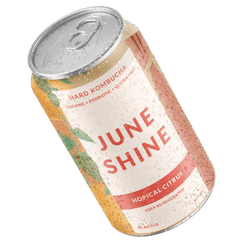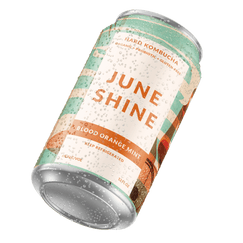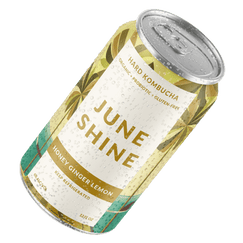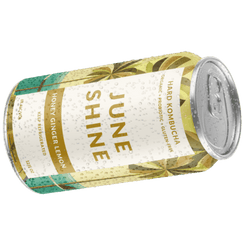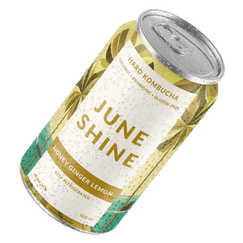The History of Kombucha and When It Became Hard

Kombucha isn’t a new thing—in fact, it was around for thousands of years before we put our own hard twist on it. Let’s run through the history of kombucha so you better understand the background of your favorite beverage and how the hard version came about.
The Beginnings of Booch
Like most things in history, the precise origins of kombucha are often disputed. Most agree that around 220 BCE, members of China’s Qin Dynasty began creating recipes for kombucha.
Brewers living in present-day Korea and China figured out how to take yeast and symbiotic cultures and form them into a gelatinous substance, now referred to as SCOBY (symbiotic culture of bacteria and yeast). They then used that to ferment sweetened tea. Prized for its healing properties, the newly formed substance was dubbed the “Tea of Immortality.”
Around 414 BCE, legend has it that a Korean doctor named Dr. Kombu brought the kombucha recipe across the sea to Japan. He reportedly served it to Japan’s 19th emperor, Ingyō, who loved the drink so much he named it after Dr. Kombu. The drink also became a favorite of the samurai, who enjoyed it as an energy boost before battles.
Kombucha in the 20th Century
Kombucha eventually made its way west due to newly formed trade routes spanning East Asia, Russia, Germany, and Switzerland in the 20th century.
In 1913, a virus broke out across rural Germany. When researchers searched for a cure, they came across a small village that appeared to be immune. Their secret? Homebrewed kombucha.
It’s no surprise that kombucha’s popularity grew fast in Germany after that. By 1915, Germans were hailing their booch for its health benefits. Doctors used it to treat patients with certain ailments and compared its benefits to those of yogurt.
During World War I, the drink spread to more countries. German and Russian POWs consumed kombucha before it spread across Europe during the interbellum period.
The biggest fans of kombucha were the Russians. The drink, called “chayniy grib,” became a staple in the Soviet Union. Everyone from children to prisoners brewing batches in their cells celebrated its dry flavor. The drink was also easy to make and doubled as a digestive aid. Furthermore, research started to back the health benefits of kombucha on the blood, appetite, and intestines.
During World War II, kombucha production in Europe became limited due to a shortage of tea and sugar. In 1944, however, kombucha got its first mention in an American publication. The New York Times reported that Siberians and Manchurians used kombucha as a cure and that a sample had been obtained by American scientists for research.
Kombucha and the Olympics
Kombucha grew in popularity in California during the war and the years following. People began brewing their own kombucha and sharing it with friends and family. Thanks to a study comparing its health benefits yet again to yogurt, it also saw a boost in popularity in Switzerland.
In the 1972 Munich Summer Olympics, kombucha enjoyed a surge of popularity among Soviet athletes. Like the Samurai centuries before, the athletes believed the kombucha helped their performance. Hippies also enjoyed kombucha and shared homemade brewing techniques in their communities.
Heading Into the New Century
In the states, kombucha started to gain recognition after fermentation expert Sandor Kats sang its praises in his book, The Art of Fermentation.
In 1995, things really started to kick off when America’s first kombucha brand was founded. In another story of kombucha’s health benefits, founder GT Dave made claims about the positive effect of kombucha on his mother during her fight against breast cancer.
In 2007, kombucha was offered on tap for the first time. This inspired people to begin making kombucha mixed drinks and other concoctions never tried before.
Making Hard Kombucha
The question of when kombucha became “hard” is difficult to answer because kombucha is, by definition, fermented and slightly alcoholic. In fact, as kombucha grew in popularity in the early aughts, it hit a roadblock in 2010 due to its alcohol content.
An inspector came across a bottle of kombucha while auditing a Whole Foods in Portland, Maine, and realized that the alcohol content of kombucha could potentially give minors a buzz.
The bottles in question were submitted to a lab and came back showing alcohol levels ranging from 0.5% to 2.5%, above the legal limit set forth by the Alcohol and Tobacco and Trade Bureau of less than .5%.
Likely by mistake, many booch producers weren’t accounting for the development of a higher ABV upon the second fermentation and bottling. Due to the lack of awareness of the process, regulators were overlooking the ABV and allowing the drinks to be sold.
Once the issue was discovered, Whole Foods stopped stocking the shelves with kombucha until new regulations were developed. Well, all press is good press, as they say, and during the break in production of kombucha and the negative press that followed, consumer awareness in the United States rose dramatically.
When kombucha came back on the market, there was an outcry from those who were accustomed to kombucha's previous taste. Consumers worried that the change in the recipe would affect the health benefits as well.
With this in mind, kombucha producers began to separate into two groups: hard kombucha and those that complied with ABV guidelines.
JuneShine Hard Kombucha
Hard kombucha has since risen to popularity, but JuneShine started as an answer to the lack of sustainable and transparent alcoholic beverages out there.
We began as a team of adventurers, artists, and creatives who shared a passion for the environment and, of course, a love of booch.
We have found the perfect recipe to elevate the alcohol content of our booch while using organic honey in our fermentation process. Any residual sweetness in a sip of a Junie comes from organic fruit that we add for taste.
Nothing in here is artificial, because you’re real, and your drink should be too.
Sources:
How kombucha went from seaweed tea in Japan to a hit in North America| CBC.ca

